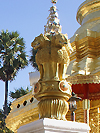|
Asoka Pillar
Name of a
series of columns found throughout northern India, often in strategic sites,
such as on trade routes, but especially at locations of historical importance to
Buddhism. They were erected by the Mauryan King
Asoka
after his conversion to Buddhism, in order to propagate the teachings of the
Buddha. Many of them
are inscribed with his edicts, in the
Prakrit language and written in the
Brahmi
script. The columns are made up of polished sandstone and
are –or were– all crowned with a capital in the form of an animal chiseled from another
single piece of stone, usually a single
lion (fig.), though the most distinguished pillar had a capital with four
lions,
portrayed seated back to back. The latter crowned a ca. 15 meter tall column (fig.) erected at the site of the Buddha’s first
sermon in
Sarnath (fig.),
in order to propagate the teachings of the
Buddha. The four lions are sometimes
interpreted to represent the four directions in which the teachings of the
Buddha are spread. The lions are perched on a circular platform (fig.), engraved with four small animal
figures, i.e. an elephant, a bull, a horse and a lion, which are separated by
dhammachakka wheels with twenty-four spokes. Whereas the lions are considered to be
the protectors of the
dhamma, the four animals represent the
Four Stages of Life or the four
ashram in the life of the Buddha,
with the elephant referring to the
White Elephant
that
appeared in the dream or
subinnimit
of
Siddhartha's mother
Maha Maya
(fig.);
the horse referring to
Kanthaka, the snow-white
horse of the prince (fig.),
that was born on the same day as its master and carried him away from the palace
during the
Great Departure
(fig.); the bull
representing the animal used in the
Royal Ploughing Ceremony
performed by his father when Siddhartha was 7 years old and where he for the
first time was confronted with the suffering of another being, i.e. a worm that
was accidentally cut in two by the ploughshare, and which initiated his
search to end all suffering in the world, and
additionally the bull represents the constellation that corresponds to the day of the full moon in
the month
Visakha, the month
of the
Phrasut
(birth),
Enlightenment
and
Parinippahn
(passing away) of the Buddha; and the lion being the protector of the
dhamma, although some believe it may also be the symbol of the
Sakya clan. The platform itself rests on an inverted
lotus flower, a
Buddhist symbol of
Enlightenment. Reminiscent of the
Garuda in
Thailand, the capital of the Asoka Pillar is the national emblem of India and is depicted on
official government documents, such as the Indian passport, as well as on all
banknotes and coins. The Indian national emblem also has an inscription of the words ‘Truth
Alone Triumphs’ inscribed, in
Devanagari
script. Reproductions of the Asoka capital are sometimes found in Buddhist temples
across Thailand.
See THEMATIC STREET LIGHT.
回






|

